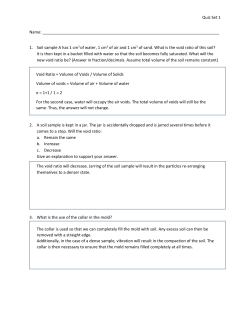
Document 371438
GeotechnicalEngineeringResearchLaboratory EdwardL.Hajduk,D.Eng,PE OneUniversityAvenue Lecturer Lowell,Massachusetts01854 Tel:(978)934‐2621 Fax:(978)934‐3052 e‐mail: Edward_Hajduk@uml.edu website:http://www.uml.edu/research_labs/Geotechnical_Engineering/default.html DEPARTMENTOFCIVILANDENVIRONMENTALENGINEERING 14.531 ADVANCED SOIL MECHANICS FALL 2014 MID-TERM EXAM QUESTIONS: Each problem is worth 2 points unless specified. You do not need to follow assignment guidelines for these questions for full credit. 1. Which of the following is true of dilation of sand (mark all that apply)? a. The magnitude of shear resistance is proportional to the rate of volume change. b. Some dense sands do not dilate due to angularity. c. It is caused by particle interlocking and occurs even at a constant volume condition. d. All of the above. 2. Briefly describe the influence of relative density on the stress-strain-strength behavior of sand in a triaxial compression test. Why does dense sand have a different peak friction angle than loose sand? 3. Is it possible to have a material that increases in volume when subjected to an increase in effective stress? Briefly explain your answer. Use the following diagram to complete Questions 4, 5, and 6. Kf Line q+ B Ko Line A C p+ 4. Which stress path corresponds to an isotropically consolidated, failed in triaxial compression, unloading condition? Brief explain how you arrived at that conclusion. 5. Which stress path corresponds to a Ko consolidated, 1-D compression loading condition? Brief explain how you arrived at that conclusion. 14.531 2014 Mid-Term Exam Page 1 of 10 6. Which stress path corresponds to a Ko consolidated, failed in triaxial compression, loading condition? Brief explain how you arrived at that conclusion. 7. A clay made up of “hollow tube” particles is: a. b. c. d. Halloysite Muscovite Kaolinite None of the Above 8. If I have an undisturbed clay with a plasticity index of 24% and a plastic limit of 39%, what would be your estimate of the compression index (Cc)? 9. Once upon a time, a science teacher told a student that a half-glass of soil which is filled to the top with water weighs more than a full glass of dry soil alone. At which void ratio(s) is this true? Assume that the soil in the bottom half of the first glass is completely saturated but otherwise identical to the dry soil in the second glass. Note that Gs = 2.62. (This question is worth 4 points). PROBLEMS: Each problem is worth 20 points. You must follow assignment guidelines for these four problems for full credit. PROBLEM #1: You have been assigned a project site in the area. The subsurface exploration and subsequent testing and analysis have yielded the following soil profile (Note: The site is dry sand. The groundwater table was not located). Depth (ft) d (pcf) (°) 0-12 110 32 12-50 120 38 The foundation for your project is a 15ft diameter concrete mat with a uniform applied contact stress of 2.5 ksf. For this problem, plot the in-situ vertical effective stress, the in-situ horizontal effective stress, the change of vertical effective stress (v), and the final vertical effective stress with depth at the center of the footing to a depth of 50 ft. PROBLEM #2: You have grabbed a sample of soil from a depth of 25 ft for the site referenced in Problem #1. You run two (2) triaxial tests: a Ko consolidated compression (loading) test and a Ko consolidated extension (unloading) test. Draw the stress paths for each triaxial test. 14.531 2014 Mid-Term Exam Page 2 of 3 PROBLEM #3: The state of stress on a small element in a loose sand ( = 31°) is v = 32 kPa and the shear stress on the vertical plane is +5 kPa. Using the information provided, do the following: a. Draw Mohr’s Circle. b. Determine the location of the Origin of Planes. c. Determine the major and minor principal stresses and the planes on which they act. d. The maximum shear stress and the inclination of the plane(s) on which it acts. e. Determine if the soil is in a state of failure. Brief explain why or why not. PROBLEM #4: For the project site in Problem #1, you want to build a below ground garage using retaining walls. The bottom of the retaining wall will be at a depth of 10 ft below the existing ground surface. Calculate the active and passive thrusts on the retaining walls. 14.531 2014 Mid-Term Exam Page 3 of 3
© Copyright 2025





















